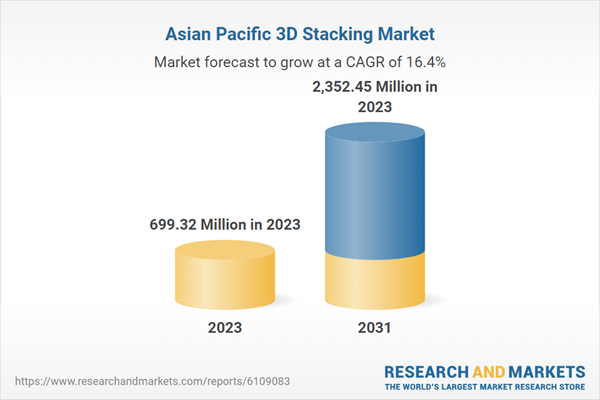Surge in Demand for High-Bandwidth Memory Fuels Asia Pacific 3D Stacking Market
High-bandwidth memory (HBM), which reaches extremely high density by stacking numerous dynamic random-access memory (DRAMs) vertically, is distinguished by rapid data processing and low power consumption. It is essential in high-performance computing (HPC), such as generative AI, which requires processing enormous amounts of data at significantly fast speeds. Samsung Electronics 12-layer stacked HBM uses next-generation 3D stacking packaging technique to boost performance and yield. With a processing speed of 6.4Gbps and a bandwidth of 819 GB/s, HBM3 is 1.8 times faster than the previous-generation DRAM while using 10% less power. The demand for HBM in high-performance computing applications encourages market players to increase their production. For instance, in March 2024, SK HYNIX INC started volume production of HBM3E1, the newest AI memory product with ultra-high performance. HBM3E is designed for an AI system that processes a huge amount of data quickly. The high-bandwidth memory is used by various industries, including telecommunication, automotive, healthcare, and manufacturing, for high-speed data processing.HBM utilizes 3D stacking technology, allowing the stacking of multiple layers of chips using vertical channels known as through-silicon vias (TSVs). This enables a greater number of memory chips to be packed into a smaller space, minimizing the distance data must travel between the memory and processor. HBM can help lengthen battery life and reduce energy consumption by offering sustainable benefits to users. This supports users in decreasing the amount of power required to transmit data between memory and processor. Therefore, the surge in demand for high-speed data processing and low-power consumption memories is expected to create lucrative opportunities for the 3D stacking market growth during the forecast period.
Asia Pacific 3D Stacking Market Overview
In Asia Pacific, China is the largest manufacturer of consumer electronic devices. According to Nikkei Inc., the Government of China expanded the country's domestic electronic market by investing US$ 327 billion till 2023. The Government of India also aims to expand the electronics market in the country. Furthermore, the electronics sector in Asia Pacific accounts for 20-50% of Asia Pacific's total value of exports. Smart speakers, home assistants, and smart cameras utilize 3D stacked memory and processors to enhance performance and features while maintaining a small footprint. As Asia Pacific is the largest electronic manufacturer, the demand for 3D stacking is expected to rise during the forecast period.Asia Pacific 3D Stacking Market Segmentation
The Asia Pacific 3D stacking market is categorized into interconnecting technology, device type, end user, and country.Based on interconnecting technology, the Asia Pacific 3D stacking market is segmented into through-silicon via, monolithic 3d integration, and 3d hybrid bonding. The through-silicon via segment held the largest market share in 2023.
By device type, the Asia Pacific 3D stacking market is segmented into memory devices, mems/sensors, LEDs, imaging & optoelectronics, and others. The memory devices segment held the largest market share in 2023.
In the terms of end user, the Asia Pacific 3D stacking market is segmented into consumer electronics, telecommunication, automotive, manufacturing, healthcare, and others. The consumer electronics segment held the largest market share in 2023.
By country, the Asia Pacific 3D stacking market is segmented into India, China, Japan, South Korea, Taiwan, Australia, and the Rest of Asia Pacific. Taiwan dominated the Asia Pacific 3D stacking market share in 2023.
Taiwan Semiconductor Manufacturing Co Ltd; Samsung Electronics Co Ltd; Intel Corp; MediaTek Inc.; Texas Instruments Inc; Amkor Technology Inc; ASE Technology Holding Co Ltd; Advanced Micro Devices Inc.; 3M Co.; and Globalfoundries Inc are some of the leading companies operating in the Asia Pacific 3D stacking market.
Reasons to Buy
- Save and reduce time carrying out entry-level research by identifying the growth, size, leading players, and segments in the Asia Pacific 3D stacking market.
- Highlights key business priorities in order to assist companies to realign their business strategies
- The key findings and recommendations highlight crucial progressive industry trends in the Asia Pacific 3D stacking market, thereby allowing players across the value chain to develop effective long-term strategies
- Develop/modify business expansion plans by using substantial growth offering developed and emerging markets
- Scrutinize in-depth Asia Pacific market trends and outlook coupled with the factors driving the Asia Pacific 3D stacking market, as well as those hindering it
- Enhance the decision-making process by understanding the strategies that underpin commercial interest with respect to client products, segmentation, pricing, and distribution.
Table of Contents
Companies Mentioned
Some of the leading companies in the Asia Pacific 3D Stacking Market include:- Taiwan Semiconductor Manufacturing Co Ltd
- Samsung Electronics Co Ltd
- Intel Corp
- MediaTek Inc
- Texas Instruments Inc
- Amkor Technology Inc
- ASE Technology Holding Co Ltd
- Advanced Micro Devices Inc
- 3M Co
- Globalfoundries Inc
Table Information
| Report Attribute | Details |
|---|---|
| No. of Pages | 179 |
| Published | April 2025 |
| Forecast Period | 2023 - 2031 |
| Estimated Market Value in 2023 | 699.32 Million in 2023 |
| Forecasted Market Value by 2031 | 2352.45 Million by 2031 |
| Compound Annual Growth Rate | 16.4% |
| Regions Covered | Asia Pacific |
| No. of Companies Mentioned | 11 |









